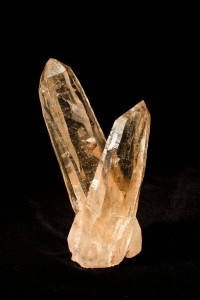Quartz of Many Colors
 Quartz is an incredibly durable mineral because it can be found in a variety of forms and mineral environments. The mineral’s compact forms of silica are used in many products and applications that inspired a need to classify its many varieties in the 18th and 19th century. In fact, there are more variety names for Quartz than any other mineral.
Quartz is an incredibly durable mineral because it can be found in a variety of forms and mineral environments. The mineral’s compact forms of silica are used in many products and applications that inspired a need to classify its many varieties in the 18th and 19th century. In fact, there are more variety names for Quartz than any other mineral.
The chemical properties of Quartz were observed by Swedish chemist Torbern Olof Bergman near the end of the 18th century.[1] Bergman originally classified Quartz as a type of silica, but it wasn’t until another Swedish chemist Jöns Jacob Berzelius decomposed Quartz with potassium to discover the element Silicon.[2] This led to the further classification of Quartz varieties into the many types that we see today.
How Quartz Are Classified
The modern classification scheme used by most mineralogist looks for differences in structure, physical properties and visual appearance in its groupings. These classifications where chosen after the older classification schemes where found to be inconsistent.
Older classification schemes based their groupings strictly on visual appearance, creating three main groupings:
- Macrocrystalline Quartz: Specimens of visible crystals like Amethyst and Citrine.
- Microcrystalline Quartz: Specimens of visibly tiny or microscopic crystals like Chalcedony.
- Cryptocrystalline Quartz: Dense specimens with no visual crystal structures like Agates.
Taking from the older classification scheme, the modern classification scheme combines Microcrystalline and Cryptocrystalline structures into a single category, otherwise known as Chalcedony. Macrocrystalline was also simplified to rock crystals, otherwise known as simple Quartz.
The Modern Classification Scheme for Quartz
Unlike the older classification schemes, the modern classification scheme for Quartz takes into consideration the structure and physical properties of each specimen to create two types: Quartz and Chalcedony. These properties allow for clearer division between specimens whose structures appear in a gradient.
Macrocrystalline Quartz – “Quartz”
The Macrocrystalline Quartz forms when molecules are layered on the crystal’s surface, creating a denser structurer. Some of the more well-known varietals under Macrocrystalline include: Amethyst, citrine, eisenkiesel (hematite included quartz), smoky quartz, and rose quartz, but quartz can be found in a wide variety of hues based on the inclusions of different minerals that result in different colorations.
[justified_image_grid ids=4343,4344,4348,4349,4350,4351,4352,4353,4354,4355 title_field=off link_title_field=off lightbox=magnific img_alt_field=caption]
Microcrystalline/ Cryptocrystalline Quartz – “Chalcedony”
Chalcedony types of Quartz minerals fall under two main types of variety – fibrous and grainy. These physical characteristics form under specific environmental conditions that lead to a microscopic layering of crystal fibers. The distinction between fibrous and grainy is made in reference to the alignment of these fibers.
The fibrous varieties of Chalcedony have fibers that clearly lie parallel to each other and follow an axis. Their structure is more translucent than the grainy variety, allowing for a richer depth of color. Fibrous varieties of Chalcedony are: Agate, Chalcedony, Onyx, and Sard.
The grainy varieties of Chalcedony have fibers that are tightly inter-grown, making them birefringent. Specimens of the grainy variety are: Chert, Flint, Jasper, and Heliotrope.
[justified_image_grid ids=4360,4361,4362,4345,4363,4346 title_field=off link_title_field=off lightbox=magnific img_alt_field=caption]
The Quartz crystal is one of the most enduring types of mineral found on earth with species originating in a variety of mineral environments around the world. Their silicon dioxide chemical makeup are malleable to many physical characteristics, forms, colors, and luminosity, making each specimen truly unique.
[box]Love quartz? Check the gallery of quartz
specimens for sale![/box]
 The Arkenstone is proud to participate in rare rock and mineral exhibits around the world. This year, we are happy to announce our involvement in this year’s Dallas Mineral Collecting Symposium at the Eisemann Center. The symposium will feature world-renowned speakers to share their latest collections and experiences in the field.
The Arkenstone is proud to participate in rare rock and mineral exhibits around the world. This year, we are happy to announce our involvement in this year’s Dallas Mineral Collecting Symposium at the Eisemann Center. The symposium will feature world-renowned speakers to share their latest collections and experiences in the field.
Don’t forget to check our listings for our shows. We’d love to meet with you and talk about the various collections!
[1] “George K. “The Life and Work of Hauey”. American Mineralogist. http://www.minsocam.org/msa/collectors_corner/arc/hauyii.htm
[2] Steve G. “The Element Silicon”. Jefferson Lab. http://education.jlab.org/itselemental/ele014.html